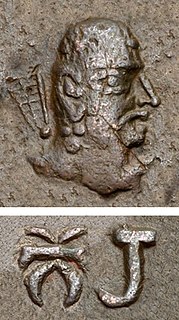
Ayodhya is a city located in the Faizabad district of Uttar Pradesh, India. It shares municipal corporation with its neighbouring twin town of Faizabad. The city is identified with the legendary city of Ayodhya, and as such, is the birthplace of Rama and setting of the epic Ramayana. The accuracy of this identification is central to the Ayodhya dispute: modern scholars variously believe that the present-day Ayodhya is same as the legendary Ayodhya, or that the legendary city is a mythical place that came to be identified with the present-day Ayodhya only during the Gupta period around the 4th-5th century CE.

The Maitraka dynasty ruled western India from approximately 475 to approximately 776 CE from their capital at Vallabhi. With the sole exception of Dharapatta, who followed the Mithraic mysteries, they were followers of Shaivism. Their origin is uncertain but they were probably Suryavanshi Kshatriyas.

The Sena Empire was a Hindu dynasty during the Late Classical period on the Indian subcontinent, that ruled from Bengal through the 11th and 12th centuries. The empire at its peak covered much of the north-eastern region of the Indian subcontinent. The rulers of the Sena Dynasty traced their origin to the south Indian region of Karnataka.

Shashanka was the first independent king of a unified polity in the Bengal region, called the Gauda Kingdom and is a major figure in Bengali history. He reigned in 7th century AD, and some historians place his rule between circa 600 C.E and 636/7 C.E. Other sources place his reign between 590 and 625 C.E.

The Western Satraps, Western Kshatrapas, or Kshaharatas were Indo-Scythian (Saka) rulers of the western and central part of India. The Western Satraps were contemporaneous with the Kushans who ruled the northern part of the Indian subcontinent and were possibly their overlords, and the Satavahana (Andhra) who ruled in Central India. The power of the Saka rulers started to decline in the 2nd century CE after the Saka rulers were defeated by the south Indian Emperor Gautamiputra Satakarni of the Satavahana dynasty. Later the Saka kingdom was completely destroyed by Chandragupta II of the Gupta Empire in the 4th century CE.

Dahod District is located in Gujarat state in western India, called after its administrative HQ. It has a population of 21,26,558, with a population density of 583 persons per km².

The Vakataka Empire was a dynasty from the Indian subcontinent that originated from the Deccan in the mid-3rd century CE. Their state is believed to have extended from the southern edges of Malwa and Gujarat in the north to the Tungabhadra River in the south as well as from the Arabian Sea in the west to the edges of Chhattisgarh in the east. They were the most important successors of the Satavahanas in the Deccan and contemporaneous with the Guptas in northern India.

Dakshina Kosala is a historical region of central India. It was located in what is now Chhattisgarh and parts of western Odisha. At its greatest extent, it may have also included a part of the Vidarbha region in present-day Maharashtra.

Mihirakula, also Mihiragula or Mahiragula, was one of the most important rulers of the Alchon Huns, who led a conquest and gained temporary control of Gandhara, Kashmir, northern and central India. Mihirakula was a son of Toramana, both of Huna heritage, and ruled the Indian part of the Hephthalite Empire. Mihirakula ruled his empire from 502 to 530, from his capital of Sagala.
Manigiramam, or manigramam, typically refers to a medieval merchant guild, organised by itinerant ethnic Indian traders, primarily active in south India. Along with the ainurruvar and the anjuvannam, the manigiramam played a major role in the commercial activities of the region. Unlike the anjuvannam which was confined to the port-towns of south India, the manigramam is found both in the port-towns and in the hinter-land trade centres.

The Early Period of Kamarupa stretches from early times to the 7th century A.D.

The Rāmtek Kevala Narasiṃha temple inscription is an epigraphic record of the Vākāṭaka dynasty, documenting the construction of a temple dedicated to the Narasiṃha or lion-man incarnation (avatāra) of Viṣṇu. The inscription dates to the 5th-century CE. The inscription is presently built into an interior wall of the Kevala Narasiṃha temple at Ramtek, in Nagpur district, Maharashtra, India. The inscription is written in 15 lines of Sanskrit but is damaged. It records the lineage of the Vākāṭaka rulers and the foundation of the temple. The inscription is composed in Puṣpitāgrā, Upajāti and Śloka metres.

The Pushyabhuti dynasty, also known as the Pushpabhuti dynasty or Vardhana dynasty, ruled parts of northern India during 6th and 7th centuries. The dynasty reached its zenith under its last ruler Harsha-Vardhana, whose empire covered much of north and north-western India, and extended till Kamarupa in the east and Narmada River in the south. The dynasty initially ruled from Sthanvishvara, but Harsha eventually made Kanyakubja his capital, from where he ruled until 647 CE.

Bhanugupta was one of the lesser known kings of the Gupta dynasty. He is only known from an inscription in Eran, and a mention in the Manjushri-mula-kalpa.
The Saindhavas, also known as Jayadrathas, ruled western Saurashtra from c. 735 CE to c. 920 CE, probably in alliance with Maitrakas in early years. Their capital was at Bhutamabilika (now Ghumli. The known historical events during their rule are the attacks of Arabs repulsed by Agguka I.

The Deva dynasty of Saketa, was a dynasty of kings who ruled in the area of the city of Ayodhya, Kosala, in India from the 2nd century BCE until the end of 1st century BCE.

The Rīsthal inscription is a stone-slab inscription which was discovered in 1983 in the area of Rīsthal in Ghazidabad, Uttar Pradesh, India.

Ayodhya is a legendary city mentioned in the ancient Sanskrit-language texts, including the Ramayana and the Mahabharata. These texts describe it as the capital of the Ikshvaku kings, including Rama.



















